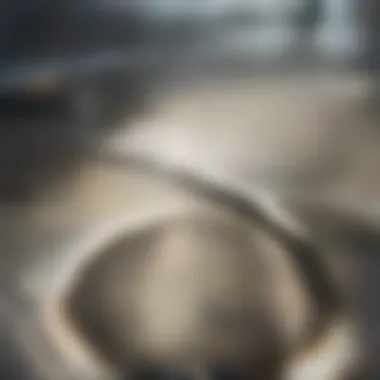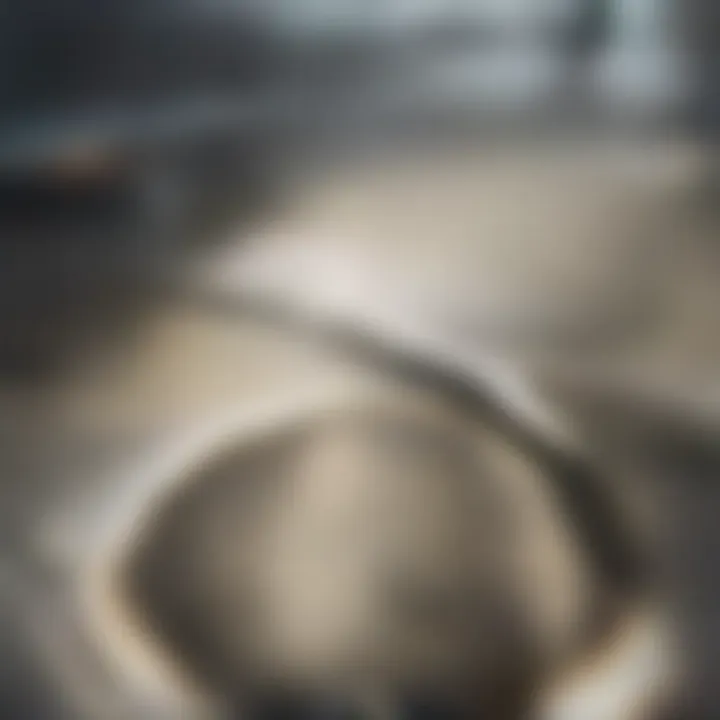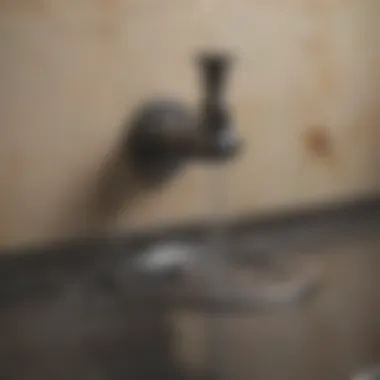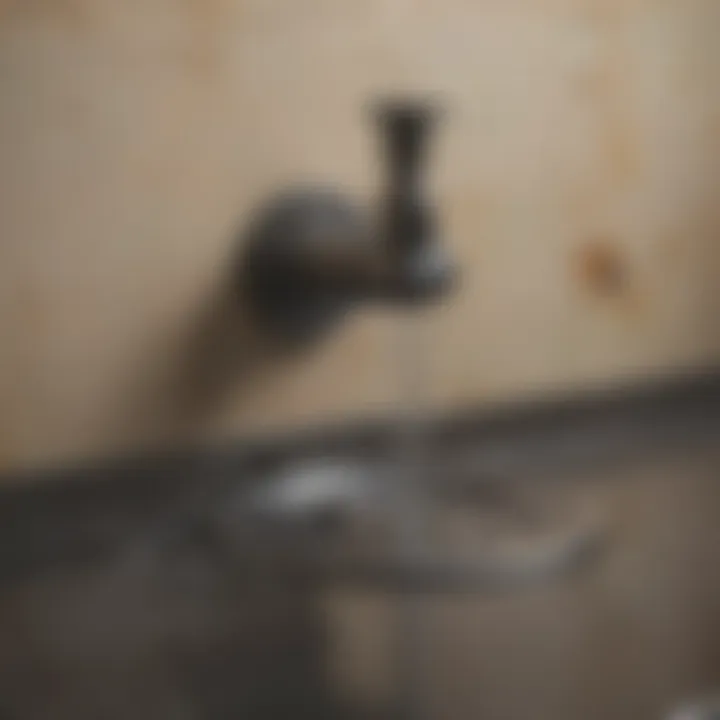Best Practices to Unclog Shower Drains Effectively


Intro
Clogged shower drains are a common annoyance for homeowners. These blockages can lead to unpleasant odors, slow drainage, and even water damage if left unaddressed. Understanding how to effectively unclog shower drains is essential for maintaining a healthy home environment. This article will explore various methods to tackle drain clogs, focusing on both preventative measures and practical solutions. Engaging with this content will equip readers with the knowledge necessary to handle shower drain issues with confidence.
Best Practices for Unclogging Shower Drains
Understanding the Causes
Before diving into solutions, it is vital to understand the common causes of shower drain clogs. Hair buildup is often the main culprit. Over time, strands of hair combine with soap residue and other debris, forming a blockage. Additionally, mineral deposits from hard water can contribute to clogging. Regular maintenance can prevent many problems before they escalate.
Preventative Measures
Adopting preventative techniques can significantly reduce the frequency of drain issues. Consider the following practices:
- Use Drain Screens: Install a mesh screen over the drain to catch hair and large particles, preventing them from entering the pipes.
- Regularly Remove Debris: Periodically clean the drain screen and remove any visible hair or debris to mitigate buildup.
- Flush with Hot Water: Once a week, pour boiling water down the drain. This will help dissolve any soap scum and mineral deposits.
DIY Solutions
If a clog has already formed, several DIY methods may help you restore proper drainage. Here are effective solutions:
- Plunger: A standard plunger can work wonders by creating pressure to dislodge the clog. Ensure to cover the overflow drain to create an effective seal.
- Baking Soda and Vinegar: This classic combination can break down debris naturally. Pour half a cup of baking soda followed by half a cup of vinegar down the drain. Let it sit for 30 mins, then flush with hot water.
- Plumbing Snake: If other methods fail, a plumbing snake can physically remove the clog. Insert the snake into the drain and twist until you feel resistance.
Chemical Solutions
When natural methods do not suffice, chemical drain cleaners may be appropriate. However, use these with caution as they can be harsh and damage pipes if misused. It is advisable to follow the manufacturer’s directions carefully, ensuring proper ventilation during use.
Safety Considerations
Handling chemicals and tools requires precautions. Always wear gloves and eye protection. Ensure the area is well-ventilated to prevent inhalation of fumes. Additionally, avoid mixing different chemical cleaners as this can cause dangerous reactions.
Synthesis of Information
Creating a proactive approach to drain maintenance can save homeowners time and money. Regular inspections and the immediate address of minor clogs can prevent more significant issues. Employing both natural and chemical methods, combined with proper tools, allows for thorough care of shower drains.
"The key to avoiding severe clogs is proactive maintenance and immediate action when problems begin."
Maintaining shower drains is a straightforward, yet crucial task for any homeowner. By implementing best practices and understanding the root causes of clogs, you can create a healthy, functioning home environment.
Understanding Shower Drains
Understanding the intricacies of shower drains is pivotal for effective maintenance and unclogging. Shower drains serve as the critical component in directing wastewater away from your home, ensuring hygiene and comfort. A well-functioning drain minimizes unpleasant odors and prevents water stagnation, which can lead to bigger issues.
The design of a shower drain impacts its performance. Recognizing the types of drains, their construction, and the materials used, can help anticipate potential problems. Moreover, being informed about how shower drains operate contributes to proactive home maintenance.
Establishing a keen understanding of shower drains not only aids in timely interventions when issues arise but also enhances overall household management. With clearer insight, homeowners can navigate clogs more adeptly and make informed decisions regarding preventative measures.
Types of Shower Drains
The landscape of shower drains encompasses various designs, each tailored for specific installation needs and aesthetics. The most common types include:
- Point Drains: These are the traditional, widely used drains situated in the center of the shower floor. They effectively collect water as it drains down.
- Linear Drains: A more modern design, linear drains run along one wall or the perimeter of the shower. This design allows for a more seamless look and is easier to manage for larger shower spaces.
- Tile-Insert Drains: Disguised with tiles, these provide an elegant finish. They are often used with linear drains but can also be found in point drainage systems.
Each type has its advantages and can affect how easily clogs form. For instance, point drains may require more frequent maintenance to prevent buildup, while linear drains can handle larger volumes of water effectively.
Common Causes of Clogs
Clogs can spring from various sources, often leading to frustration. The most prevalent causes include:
- Hair: A leading contributor to clogs. Hair can trap soap residue and other debris, forming a solid mass over time.
- Soap Scum: The buildup of soap particles mixes with minerals in water, hastening the clogging process.
- Foreign Objects: Any small item that accidentally falls into the drain, like shampoo caps or small toys, can initiate blockages.
Awareness of these common culprits is essential for prevention. Regular inspections and maintenance can significantly reduce the likelihood of encountering severe clogs.


"The best defense against drain clogs is a good offense, involving routine maintenance and simple preventive actions."
Ultimately, understanding how your shower drain operates and the typical issues it faces prepares homeowners for efficient solutions when problems arise.
Prevention Strategies
Preventing clogs in shower drains is essential for maintaining both the efficiency of your plumbing system and the longevity of your fixtures. By implementing effective prevention strategies, you can significantly reduce the likelihood of experiencing messy and frustrating clogs. This section outlines various methods that not only help avoid blockages but also promote better hygiene and cleanliness within your bathroom.
Regular Maintenance Practices
Establishing a routine for maintaining your shower drains can be one of the most impactful strategies to prevent clogs and associated problems. Regular maintenance practices involve simple tasks that can easily be integrated into your cleaning schedule.
- Routine Cleaning: Periodic cleaning of the shower drain is crucial. It helps to remove hair, soap residue, and other debris that accumulate over time. Use a mixture of warm water and dish soap to flush the drain once a month.
- Inspection: Regularly check the drain for any visible signs of blockage. If you notice anything obstructing the drain flow, act promptly.
- Hair Removal: For households with long hair, consider investing in a drain strainer. You can also use a wire hanger to carefully pull out hair stuck in the drain without causing damage.
Using Drain Covers
Using drain covers or strainers is a straightforward yet effective way to prevent clogs from forming in the first place. These tools serve as the first line of defense against hair and debris entering the drain. Here are some important points to consider regarding drain covers:
- Types of Covers: There are various styles of drain covers available, including flat, mesh, and dome-shaped. Select one that fits securely over your drain while also being easy to clean.
- Material Selection: Drain covers are typically made from materials such as stainless steel or plastic. Stainless steel is durable and resistant to rust, while plastic is often lighter and easier to handle.
- Ease of Maintenance: Ensure that the drain cover you choose can be easily removed for cleaning. A cover that collects hair should be emptied regularly, ideally after each shower.
"An ounce of prevention is worth a pound of cure." Maintaining clean drains not only helps in preventing clogs but also promotes better hygiene in your bathroom.
DIY Methods for Unclogging
DIY methods play a crucial role in the quest for unclogging shower drains. These techniques are often straightforward, requiring minimal supplies that most households have on hand. Employing DIY methods allows homeowners to take immediate action without relying on external help, fostering both independence and cost savings. Furthermore, many DIY solutions utilize natural ingredients which may be less harmful to the environment compared to commercial products. Below are three effective DIY methods discussed in detail.
Boiling Water Technique
The boiling water technique is perhaps one of the simplest yet effective methods to unclog a shower drain. This method works by using heat to break down any grease or soap build-up in the pipes. To perform this technique, boil a large pot of water. Carefully pour it down the drain in stages. First, allow the water to work for a few minutes, then repeat the process.
This method is effective for minor clogs caused by soap residues or hair. However, it is important to avoid this method if your pipes are PVC, as the high temperature may cause damage. Regular use of boiling water can also serve as preventive maintenance.
Using Baking Soda and Vinegar
Combining baking soda and vinegar is another excellent way to tackle clogs. To start, pour half a cup of baking soda down the drain followed by half a cup of vinegar. Cover the drain with a stopper or cloth to contain the reaction. Let it sit for about 30 minutes. The fizzing action helps to break down stubborn deposits.
After the wait, flush the drain with hot water to wash away debris. This method is eco-friendly and avoids harsh chemicals, making it a preferred choice for households looking for a natural solution. Additionally, using baking soda and vinegar periodically can keep drains healthier over time.
Plumbing Snake Application
A plumbing snake, or auger, is a more hands-on method for removing clogs. This tool is designed to navigate through pipes and physically break up or extract obstructions. To use a plumbing snake, insert the end into the drain and turn the handle clockwise. As you push forward, the snake will catch debris, allowing you to pull it out.
This method is particularly effective for deep-rooted clogs that cannot be removed by chemical solutions or hot water. A plumbing snake is an investment that pays off because it can address a variety of clogs throughout the home. It is worth noting the importance of using the snake carefully to avoid damaging pipes during application.
"Utilizing DIY methods can empower homeowners to manage and maintain their shower drain systems effectively."
Each of these methods offers unique benefits and considerations, allowing individuals to choose according to their specific situation. Taking these approaches can not only resolve current clogs but also aid in preserving the long-term health of your shower drains.
Chemical Solutions
Chemical solutions play a crucial role in the arsenal of methods for unclogging shower drains. They can effectively dissolve stubborn blockages that tend to accumulate over time, often composed of hair, soap residue, and other organic materials. These solutions are beneficial due to their efficiency, speed, and ease of use. Unlike some mechanical methods, chemical options often require minimal physical effort, appealing to a wide audience looking for quick resolutions to frustrating plumbing issues.
However, it is essential to approach the use of chemical solutions with caution. Understanding how these chemicals work and being aware of their potential risks can enhance the effectiveness of the process while ensuring safety.
Commercial Drain Cleaners
Commercial drain cleaners are perhaps the most widely recognized chemical solutions available. Products such as Drano, Liquid-Plumr, and ZEP can be found in most retail stores, providing homeowners with convenient options. These cleaners generally contain powerful ingredients that are designed to break down clogs quickly. The effectiveness of commercial drain cleaners can vary based on the type of blockage and the formulation of the cleaner.
- Types of Commercial Drain Cleaners:
- Liquid Cleaners: Typically easy to use, these products flow into the drain and dissolve clogs effectively.
- Foaming Cleaners: These cleaners expand in the drain, allowing for more thorough coverage of the clog.
- Enzyme-Based Cleaners: A more eco-friendly option, these cleaners often utilize natural enzymes to break down organic waste, making them less harsh than their chemical counterparts.


Using these cleaners often involves following the instructions and applying them directly to the drain. However, users should not expect instant results. Sometimes, allowing the product to sit for a while is necessary for optimal effect. Each product varies, so it’s critical to read the labels and select accordingly.
Safety Precautions
As effective as chemical solutions can be, they come with inherent risks. It is vital to prioritize safety to avoid injuries and minimize harmful effects on the environment.
- Protective Gear: Always use gloves and goggles when handling chemical cleaners to protect your skin and eyes from splashes.
- Ventilation: Ensure that the area is well-ventilated when using commercial cleaners. Fumes can be harmful if inhaled in concentrated amounts.
- No Mixing: Never mix different chemical cleaners. Combining products can result in dangerous chemical reactions.
- Disposal: Dispose of any leftover cleaner responsibly, following local regulations regarding hazardous waste.
Chemical solutions can be an effective method for unclogging drains but must be used with caution.
By considering these safety precautions and understanding the benefits of commercial drain cleaners, homeowners can tackle shower drain clogs effectively while also protecting themselves and the environment.
When to Call a Professional
Recognizing when to call a professional plumber is critical in managing shower drain issues. The importance lies not only in resolving the current problem but also in preventing future complications. Many homeowners attempt to tackle severe clogs on their own, but this can lead to further damage or a temporary fix instead of a lasting solution. Knowing when to seek professional help can save both time and money in the long run.
Identifying Severe Clogs
Severe clogs might be characterized by multiple indicators. If water in your shower drains noticeably slower than usual or backs up completely, it may signify a severe obstruction deep within the plumbing. Odd smells can also accompany these issues, resulting from stagnant water or decaying matter.
Other signs to look out for include:
- Gurgling sounds in the drain when you run water elsewhere in the house.
- Water leaking from joints or pooling around the shower area.
- Recurring clogs despite employing various DIY methods.
These symptoms often indicate the presence of a larger blockage that may not be solvable through standard methods. In such cases, it is prudent to contact a plumber who can assess the situation more thoroughly.
Choosing the Right Plumber
Once the need for a professional has been confirmed, the next step is selecting the right plumber. This choice can directly affect the resolution of the issue and the experience you have during the process. Consider several factors:
- License and Insurance: Always verify that the plumber is licensed and insured to protect yourself from liability and ensure quality work.
- Experience: Choose someone with a track record for similar problems. Experience with specific plumbing issues is often a strong indicator of a plumber's capability.
- Reviews and References: Look for customer feedback online. Websites like reddit.com can offer real-world testimonials that help in making an informed choice.
- Cost Estimates: Request estimates from multiple plumbers to compare pricing, but be wary of unusually low bids. Quality often requires fair investment.
Choosing the right plumber is essential as they can diagnose the problem correctly and apply the appropriate solutions. A good plumber not only fixes the immediate issue but also educates the homeowner on proper drain maintenance to avoid future problems.
Tools for Drain Maintenance
The proper utilization of tools for drain maintenance can drastically improve one’s ability to handle shower clogs. Whether one opts for simple solutions or more complex interventions, having the right tools can make the process both efficient and effective. This section will delve into essential plumbing tools as well as non-chemical options for unclogging drains.
Essential Plumbing Tools
To adequately maintain and unclog shower drains, certain plumbing tools are invaluable. These tools provide convenience and greatly enhance the performance of DIY drain maintenance. Some commonly used tools include:
- Plunger: This simple yet powerful tool can often dislodge minor blockages. The suction created by the plunger can help move debris in the drain.
- Plumbing Snake or Auger: A plumbing snake is essential for tackling deeper clogs. It is designed to reach blockages that are further down the piping system, offering a more thorough solution than surface methods.
- Drain Cleaning Brush: This is particularly useful for removing hair or soap scum that builds up near the drain's entrance. The bristles can effectively dislodge materials without causing damage.
- Vise-Grip Pliers: Useful for holding onto stubborn components of the drain, such as screws or fittings that need attention.
- Bucket: When dealing with clogs that may create a mess, a bucket is essential for catching any excess water or debris.
Having these tools on hand improves one’s readiness to address clogs as they occur. Moreover, understanding how to use each tool properly can enhance their effectiveness.
Non-Chemical Tools for Unclogging
In recent years, there has been a growing interest in non-chemical tools to unclog drains. These methods tend to be more environmentally friendly and often safer for both users and plumbing systems. Here are some notable options:
- Baking Soda and Vinegar Kit: This method relies on a chemical reaction between baking soda and vinegar to break down blockage. When these two elements combine, they produce carbon dioxide, helping to dislodge clogs.
- Wet/Dry Vacuum: This versatile tool can be used to suck up debris from the drain. Particularly effective for hair clogs, it can significantly reduce the amount of manual labor involved.
- Flexible Drain Cleaning Rod: A flexible rod can navigate bends in a drain pipe better than more rigid tools. It allows for the removal of clogs without requiring excessive force that might damage pipes.
- Cable Auger: While similar to a plumbing snake, a cable auger has a more robust build that is better suited for tough clogs.
Using non-chemical tools not only minimizes damage to plumbing systems but is also a proactive way to care for the environment.
In summary, the combination of essential plumbing tools and non-chemical unclogging options provides homeowners with a comprehensive toolkit. This empowers them to manage their shower drains effectively, ensuring long-term health and functionality of their plumbing.
Long-Term Drain Health
Maintaining the long-term health of shower drains is essential for preventing future clogs and other drainage issues. When you think about it, the drain system in your home is not just a passage for wastewater; it plays a critical role in the overall plumbing infrastructure. A well-maintained drain system improves not only your shower experience but also prolongs the life of your plumbing. Ignoring these drains can lead to larger problems that require expensive repairs.
Periodic Deep Cleaning


Periodic deep cleaning involves a thorough removal of debris that builds up over time in your shower drain. This process goes beyond regular cleaning and removes even the most stubborn build-ups. Failing to perform deep cleaning can result in slower draining and odors.
Here are some effective steps for executing a deep clean:
- Gather Tools: Use a plunger, a plumber’s snake, and a bucket.
- Remove the Drain Cover: Take off the grate or cover. This establishes access to the drain.
- Use the Snake: Insert the snake into the drain to break apart any clogs. Rotate and push it further if necessary.
- Flush with Water: After clearing, flush the drain with hot water. This helps to wash away any remaining residues.
- Replace the Cover: Once finished, put the grate back in place.
By employing a periodic deep cleaning routine, you diminish the chances for clogs to develop in the future, ensuring that your shower drain remains in optimal condition.
Hydro Jetting Techniques
Hydro jetting is an efficient and powerful method used for cleaning drains. This technique employs a high-pressure water jet to clear out even the most stubborn blockages. Hydro jetting is particularly useful for homeowners who face recurring drainage problems. It is important to note that this method is best handled by professionals due to its complexity. Here are some facts about the technique:
- Effective: Hydro jetting can remove buildup caused by grease, soap scum, and mineral deposits.
- Environmentally Friendly: It uses only water, making it a green solution.
- Cost-Effective: By preventing future clogs and damage, it can save money in the long run.
Environmental Considerations
Addressing drain problems often incldes discussions on efficiency and convenience. However, it is essential to also consider the environmental impacts linked to how we approach unclogging solutions. The methods used for maintaining and unclogging shower drains can have significant consequences for the environment.
Eco-friendly practices help limit the release of harmful substances into the ecosystem. They reduce pollution in waterways and protect aquatic life from hazardous exposure. Choosing non-toxic products or reducing unnecessary chemical usage plays a role in preserving natural resources.
Homeowners can not only resolve their drain issues more sustainably but also contribute positively to their communities. This is becoming a valued perspective among residents concerned about health and environmental stewardship.
"Environmental consciousness is about creating solutions that benefit us while safeguarding the world we live in."
Eco-Friendly Cleaning Solutions
When unclogging shower drains, opting for eco-friendly cleaning solutions is increasingly popular. These solutions often emphasize natural ingredients that effectively break down clogs without causing long-term damage to plumbing systems or the environment.
Some effective methods include:
- Baking soda and vinegar: When combined, these substances create a natural reaction that can help dislodge debris.
- Salt and hot water: Using salt with boiling water can create a powerful natural cleaner.
- Natural enzymes: Products containing plant-based enzymes can help tackle organic matter build-up.
Homeowners are encouraged to explore these alternatives. They often prove to be as effective as traditional methods, with the added benefit of being safer for both plumbing systems and the environment.
Impact of Chemical Drain Cleaners
Chemical drain cleaners, while widely available, pose their own set of challenges. These cleaners often include strong acids or bases, which can dissolve clogs quickly. However, their use should be approached with caution.
Consider the following:
- Corrosive effects: Over time, these harsh chemicals can deteriorate pipes, leading to more severe plumbing issues.
- Environmental risks: When flushed down drains, chemical residues can enter local waterways, negatively impacting aquatic ecosystems.
- Health concerns: Exposure to fumes can pose health risks to individuals using these products in confined spaces.
Therefore, while chemical drain cleaners may offer immediate solutions, weighing the potential drawbacks against eco-friendly alternatives is crucial for sustainable practices.
The End
In summary, addressing shower drain clogs requires a balanced approach that includes both preventative strategies and effective unclogging methods. Understanding the various types of shower drains and their common clogging issues paves the way for effective maintenance. Preventive measures such as regular cleaning and the use of drain covers are critical. They significantly reduce the chances of clogs forming in the first place.
Summarizing Effective Practices
A systematic approach to unclogging shower drains begins with recognizing issues early. Implementing simple practices can save homeowners time and potential costs. Here are a few effective methods to keep in mind:
- Regular cleaning: Routine maintenance helps combat buildup before it turns into a significant issue.
- Natural remedies: Techniques like using vinegar and baking soda can be very effective without harmful effects on the environment.
- Professional help: Knowing when to call in a plumber can prevent minor issues from escalating and causing extensive damage.
By summarizing these effective practices, it's clear that a blend of proactivity and proper technique can mitigate drain issues.
The Importance of Regular Maintenance
Regular maintenance is not just advisable; it is essential for the longevity of shower drains. It emphasizes the significance of remaining vigilant about potential problems. Examples of effective maintenance practices include:
- Checking and cleaning drain covers regularly to ensure they are doing their job.
- Observing the water flow; slow drainage should prompt an inspection before it develops into a bigger issue.
- Performing periodic deep cleanings and considering hydro jetting for long-term health of the plumbing.
Neglecting these basic practices can lead to costly repairs and serious inconveniences. Not to mention, understanding the environmental impact of certain cleaning agents can further inform choices.
"Prevention is always better than cure."
Shower drains are often overlooked until problems arise. Yet, establishing a maintenance routine can lead to an easier, more efficient experience. Overall, by making regular care a priority, homeowners can safeguard their drains, ensuring that they remain functional and avoid clogs.







